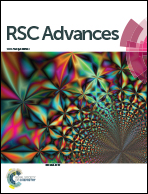Tunable PET process by the intercalation of cationic styryl dye in DNA base pairs and its application as turn-on fluorescent sensor for Ag+†
Abstract
The photoinduced electron transfer (PET) channel is tunable by the intercalation of the cationic styryl dye SPC in duplex DNA base pairs. The resulting fluorescence-quenched intercalates (DNA@SPC) show significant fluorescence enhancement upon the bonding of silver ions by blocking the PET channel, and proved to be a highly selective and sensitive fluorescent chemosensor for silver.


 Please wait while we load your content...
Please wait while we load your content...